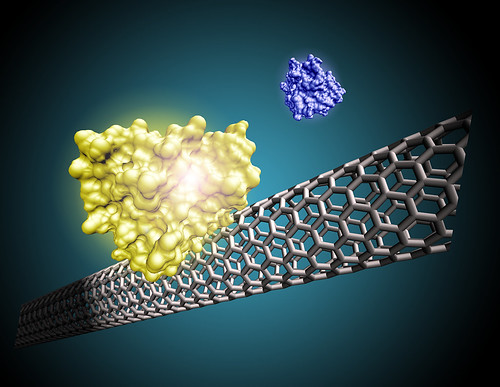CORVALLIS, Ore. – Researchers at Oregon State University have tapped into the extraordinary power of carbon “nanotubes” to increase the speed of biological sensors, a technology that might one day allow a doctor to routinely perform lab tests in minutes, speeding diagnosis and treatment while reducing costs.
The new findings have almost tripled the speed of prototype nano-biosensors, and should find applications not only in medicine but in toxicology, environmental monitoring, new drug development and other fields.
The research was just reported in Lab on a Chip, a professional journal. More refinements are necessary before the systems are ready for commercial production, scientists say, but they hold great potential.
“With these types of sensors, it should be possible to do many medical lab tests in minutes, allowing the doctor to make a diagnosis during a single office visit,” said Ethan Minot, an OSU assistant professor of physics. “Many existing tests take days, cost quite a bit and require trained laboratory technicians.
“This approach should accomplish the same thing with a hand-held sensor, and might cut the cost of an existing $50 lab test to about $1,” he said.
The key to the new technology, the researchers say, is the unusual capability of carbon nanotubes. An outgrowth of nanotechnology, which deals with extraordinarily small particles near the molecular level, these nanotubes are long, hollow structures that have unique mechanical, optical and electronic properties, and are finding many applications.
“Ideally such electronic biosensor devices would be low-cost and would quantify multiple biomarkers within a few minutes.”
This work was a collaboration of researchers in the OSU Department of Physics, Department of Chemistry, and the University of California at Santa Barbara. A co-author was Vincent Remcho, professor and interim dean of the OSU College of Science, and a national expert in new biosensing technology.
The research was supported by the U.S. Army Research Laboratory through the Oregon Nanoscience and Microtechnologies Institute.
About the OSU College of Science: As one of the largest academic units at OSU, the College of Science has 14 departments and programs, 13 pre-professional programs, and provides the basic science courses essential to the education of every OSU student. Its faculty are international leaders in scientific research.
Contact: Ethan Minot minote@physics.oregonstate.edu 541-737-9671 Oregon State University















5 comments:
But still this technology is not opened publicly.I am eagerly waiting for carbon nanotubes technology available for the world to take advantage of that.
very innovative post..which provides great information on carbon tube..In futue,This technology will help to various doctor for speeding diagnosis process,treatment and lab test..very useful post..thanx for sharing
TiO2 is one of the most studied compounds in materials science. Owing to some outstanding properties it is used for instance in photocatalysis, dye-sensitized solar cells, and biomedical devices. tio2 nanotubes is used in material science.
We should develop more advancement in our current technology to face the future's problems for our planet. It could be possible by the development of nanotechnology related materials as Nanopowder & more. In case you need high quality nanomaterial’s for your research and new product development, please visit www.nanoshel.com/product/gold-nanoparticles-drug-delivery/
In the recent years, the potential use of polymeric nanoparticles as carriers for a wide range of drugs for therapeutic applications has been increased due to their versatility and wide range of properties Due to limitations in the conventional drug therapy the increased risk of adverse reactions will occur. Nanoparticles provide the action at the desired sites and thus gaining importance nowadays. With these nanoparticles the specific targeting to various cells or receptors can be achieved. There are various mechanisms exists which are responsible for cellular internalization and cellular uptake Please Visit.www.nanoshel.com/product/titanium-diboride-nanopowder/
Post a Comment